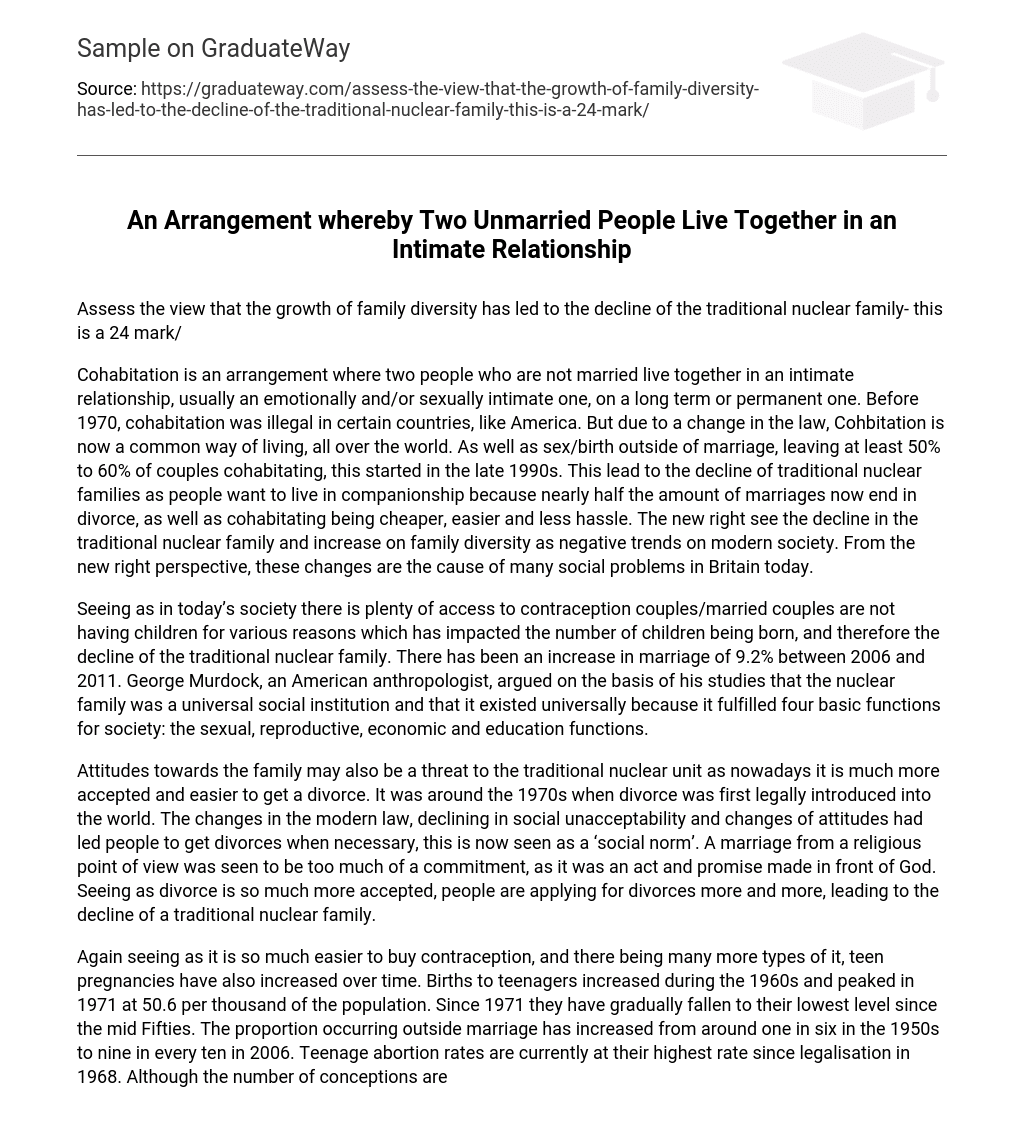Assess the view that the growth of family diversity has led to the decline of the traditional nuclear family- this is a 24 mark/
Cohabitation is an arrangement where two people who are not married live together in an intimate relationship, usually an emotionally and/or sexually intimate one, on a long term or permanent one. Before 1970, cohabitation was illegal in certain countries, like America. But due to a change in the law, Cohbitation is now a common way of living, all over the world. As well as sex/birth outside of marriage, leaving at least 50% to 60% of couples cohabitating, this started in the late 1990s. This lead to the decline of traditional nuclear families as people want to live in companionship because nearly half the amount of marriages now end in divorce, as well as cohabitating being cheaper, easier and less hassle. The new right see the decline in the traditional nuclear family and increase on family diversity as negative trends on modern society. From the new right perspective, these changes are the cause of many social problems in Britain today.
Seeing as in today’s society there is plenty of access to contraception couples/married couples are not having children for various reasons which has impacted the number of children being born, and therefore the decline of the traditional nuclear family. There has been an increase in marriage of 9.2% between 2006 and 2011. George Murdock, an American anthropologist, argued on the basis of his studies that the nuclear family was a universal social institution and that it existed universally because it fulfilled four basic functions for society: the sexual, reproductive, economic and education functions.
Attitudes towards the family may also be a threat to the traditional nuclear unit as nowadays it is much more accepted and easier to get a divorce. It was around the 1970s when divorce was first legally introduced into the world. The changes in the modern law, declining in social unacceptability and changes of attitudes had led people to get divorces when necessary, this is now seen as a ‘social norm’. A marriage from a religious point of view was seen to be too much of a commitment, as it was an act and promise made in front of God. Seeing as divorce is so much more accepted, people are applying for divorces more and more, leading to the decline of a traditional nuclear family.
Again seeing as it is so much easier to buy contraception, and there being many more types of it, teen pregnancies have also increased over time. Births to teenagers increased during the 1960s and peaked in 1971 at 50.6 per thousand of the population. Since 1971 they have gradually fallen to their lowest level since the mid Fifties. The proportion occurring outside marriage has increased from around one in six in the 1950s to nine in every ten in 2006. Teenage abortion rates are currently at their highest rate since legalisation in 1968. Although the number of conceptions are falling the proportion ending in abortion has increased over the last ten years. This rise in teen parents therefore affects family diversity as, usually the young people are not married, and so they are not a traditional nuclear family. Furthermore, young love or first sexual partners do not usually last for life so, the breaking up of the parents would lead to them becoming a single parented family. Also at the age of 16-19, most young people are still living with their parents, a beanpole family, it can include grandparents living with you in your household as well as you and your parents.
As a result of homosexuality being much more accepted in modern day society, the number of same sex couples openly living together has gone from 16,000, in 1996, to 89,000 in 2012. Moreover, the number of gay and lesbian couples bringing up children has risen by 8% since last year, according to the ONS, The Office for National Statistics. The rise in homosexual families, would consequently be another diverse family type contributing to the decline in the traditional nuclear families in Britain.
In conclusion, family diversity has risen by a significant amount over the past century and this has had a huge impact on the number of traditional nuclear families. The number of people living in family homes with children fell from 52% in 1961 to 36% in 2009, the ONS says. As you can see, a significant change has occurred in regards to the nuclear family as attitudes towards divorce, homosexuality and cohabitation have completely
reversed as all three used to be illegal. Now that people are more flexible when thinking about accepting different people and their decisions, homosexuality, for example, is now just part of everyday life for people and the people around them, mostly, accept it. There are still people who believe that it is wrong but they are just a minor part of our society. Acceptance is now the reason why the nuclear family is declining.





